"Turn left here... a day at the Hemingray BUMP!"
by Carol McDougald
Reprinted from "Crown Jewels of the Wire", December 1997, page 24
It all began sometime during the mid-70's...
The London, Ohio show was in its
infancy and was the heartbeat of our early collecting days. In fact, we were all
in our infancy...the group called themselves the Ohio Valley Insulator Club,
there were the young, squealing children of the collectors, Paul Kelly walking
around the show floor with a rare jewel on his thumb challenging someone to make
a final purchase, and the weather was lousy outside.
What I remember most about
that annual pilgrimage to mid-Ohio were the dear friends we had come to know.
And, those were the days when the diggings in Muncie, Indiana were yielding up
wonderful and exciting "never-before-seen" treasures. One table had
neatly manila and string tagged specimens that had come from Hemingray's
"dump". They were as sought after twenty or more years ago as they are
today.
Maybe some day my family would have a chance to see that old dump. Our
chance came after the national show in San Diego in 1975. We made the national
show our family vacation. We had a pop-top travel trailer we pulled behind our
station wagon. It was usually filled with more insulators than provisions,
clothes and swimming suits. We would try and stop mid-afternoon to let the boys
take a swim in a local municipal pool of a town we were passing. They were happy
days with many memories.
One mid-afternoon stop came in Muncie, Indiana. We
arranged to stop and see longtime collectors, Ken and Naomi Roach. Ken had a
wonderful collection. I still remember John and me climbing the pull-down ladder
stairs to peer into the storage below the eaves of his attic at the rows of
insulators that he had amassed from Muncie and environs. I am sure I probably
asked the boys to "Not touch!" at least a dozen times as we looked at
the priceless pieces of glass.
"Would you like to know where the dump is
that Hemingray used?" "Boy, would we?" We got directions. Driving
past the main office and plant first, we stopped to take pictures. Then it was
on to the dump on the other side of town, accessed by a residential street to a
large open field area that had been fed by a railroad spur from the main plant.
I could imagine the trainloads of rejects that had passed this way over the years.
Under our feet were millions
of broken insulators. I was probably more concerned with the safety of our sons,
Dave and Bob, than I was a getting a lot of the samples that had reached the
soil's surface. I am sure there was a lot of "Be careful, now!"...
"Watch were you are stepping!"..."Don't cut yourself!", etc.
I remember trying to come up with something safe we could carry home the items
the kids had picked up. Most children arrived home from summer vacations with
rubber lizards from souvenir shops, shells, stones, patches. Not our kids, they
had buckets of broken glass insulators. Those insulators sat in buckets in our
basement for years. I have absolutely no idea where they all went.
Our second
trip to Muncie came 22 years later. Well chronicled in this magazine have been
the diggings that have taken place on the grounds of the Hemingray plant in
Muncie. The old dump we visited years ago has long since been paved over.
However, the Hemingray factory site is still standing and ONLY collectors Roger
Lucas, Darin Cochran, and Bob Stahr have received permission from the owners to
access the site. Roger, Darin and Bob were requested to provide liability
insurance to the owners, so you can understand the delicate nature of this site.
The owners have indicated that they have and will continue to have any
trespassers arrested. This site is currently being used by a trucking company, a
metal fabricator, and for storage.
Hemingray collectors Bill and Jill Meier paid
us a visit during the summer. As a conclusion to their stay, we were invited by
Roger Lucas and Bob Stahr (with special permission granted) to meet them in
Muncie and tour the Hemingray plant grounds. We thought that there would be
little left to see having remembered what it had been like years ago.
We drove
two cars, since we were returning after the tour to Chicago and the Meiers were
heading on for New England. Jill and I rode together while Bill and John
followed in the second car. As we approached Muncie, Jill took out the map we
had been given to lead us to the plant site. We missed a turn where the street
was not marked with a road sign. I let Bill and John lead. We made several
turns. John saw a sign for Ohio Street. "Turn left here... I believe Ohio
becomes Macedonia Avenue which is where we want to go."
Jill and I watched
in horror as Bill began to slowly turn left from the middle lane. We were on a
ONE WAY street, and there was a car fast approaching in the left hand lane. Bill
and John were going to be hit. We both screamed "Watch out!" A lot of
good that did. Our visit to Muncie became.;;"Turn left here... a day at the
Hemingray BUMP!"
Fortunately, no one was hurt. Police reports completed and
with a sad looking (but drivable) front left quarter panel on Bill's silver
Lexus, we finally made it to the plant where Roger and Bob awaited.
I was amazed
at the amount of visible glass that was at the surface. In about 15 minutes, I
had picked up examples of more than a dozen CD styles. The grounds were clean.
Some buildings were abandoned, while others were a flurry of business activity.
The buildings were structurally sound. The glass furnaces looked much like they
did when production ceased, with some loose bricks around many of the openings.
Bill and Jill saw a few glass blocks on the ground as well as millions of shards
of all patterns of glass block -- a product that the plant produced as late as
1966. John kicked up a piece of a Hemingray pint wishing well water bottle in
7-up green glass in a pile of dirt beside a retaining wall. One building still had installations of glass rack spools intact next to some empty pins. We
could only imagine what threaded insulators were on those braces during
production years. It was well worth the experience to walk the hallowed grounds.
Several shovels of dirt overturned by Roger coughed up pieces of olive Hemingray
signals and matching pieces of cullet as well as a nearly whole signal in
cobalt. And, there I was again saying... "Be careful, don't cut yourself!
"
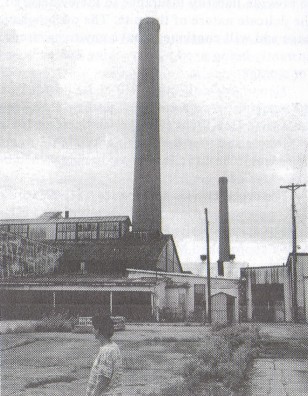
Jill Meier imagining billowing smoke and production activity.
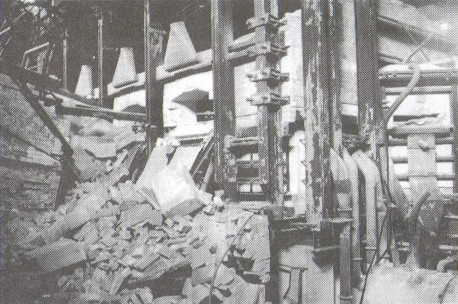
Old glass furnaces still intact with some of
the last product's glass melt
lining the walls.
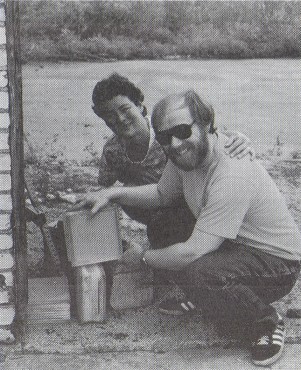
Jill and Bill Meier with some of the Hemingray glass blocks.
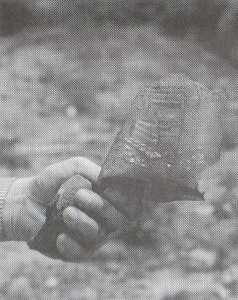
Piece of a pint!
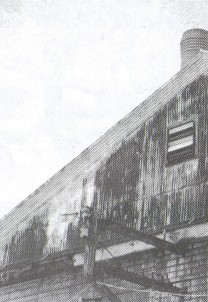
Clear Hemingray rack spools on
end of vertical brace with 10 empty
pins on
the horizontal extensions.
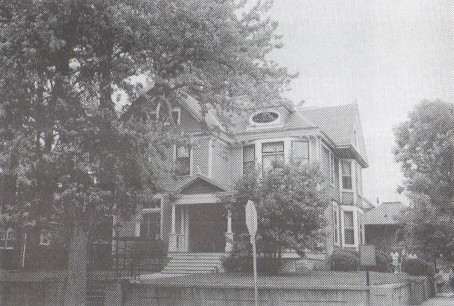
824 East Washington Street
Our last stop in Muncie was in the Emily Kimbrough
Historic District. Emily Kimbrough, a well known author, lived in Muncie from
1899 until 1909. Her book, How Dear to My Heart, describes life on East
Washington Street at the turn-of-the-century. This areas was the neighborhood of
many of Muncie's early entrepreneurs. Many fine residences, built by the city's
wealthy, are still extant for present and future citizens to admire.
The
Hemingray house is at 824 East Washington Street just inside the historic
district. The house was built in 1886 by the VanBuskirks. Ralph Hemingray bought
the house in 1910 and Minty Carol Hemingray McAbee (Ralph's daughter) obtained
the house shortly after Ralph's death. She and Phillip lived in the house until
their deaths in the mid 1940's.
Today it is called home by Bill Morgan and Pat
Mundy. While residing in the carriage house apartment which Bill renovated, he
and Pat are in the process of completely refurbishing the home of the
Hemingrays. Our gracious hosts toured us through every room. We felt a
"presence." I want to go back when they have completed the dream.
Visitors are welcome during the summer months!
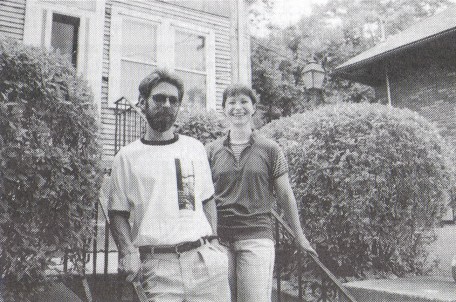
Bill Morgan and Pat Mundy are restoring the former
Hemingray home in Muncie,
Indiana.
| 